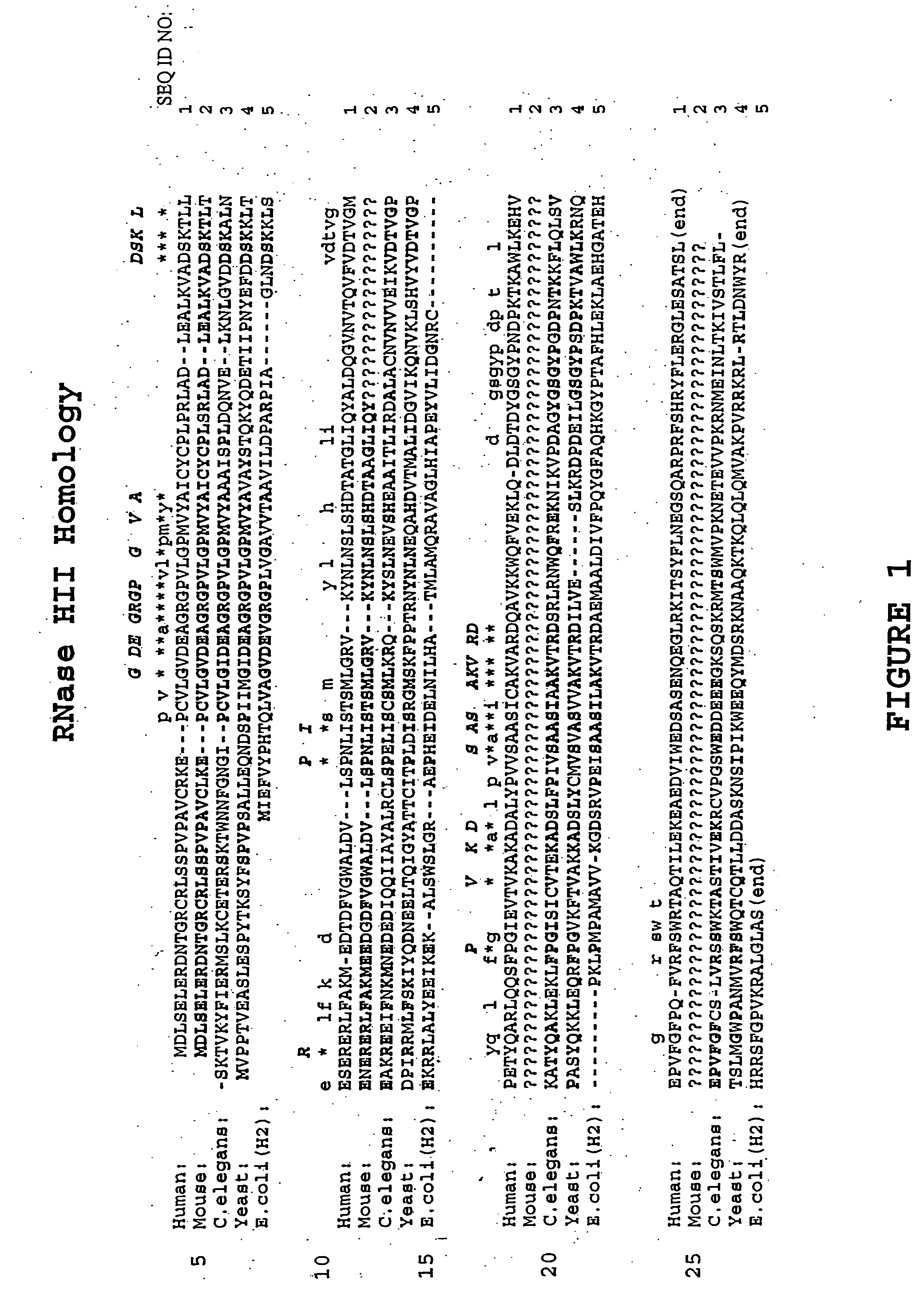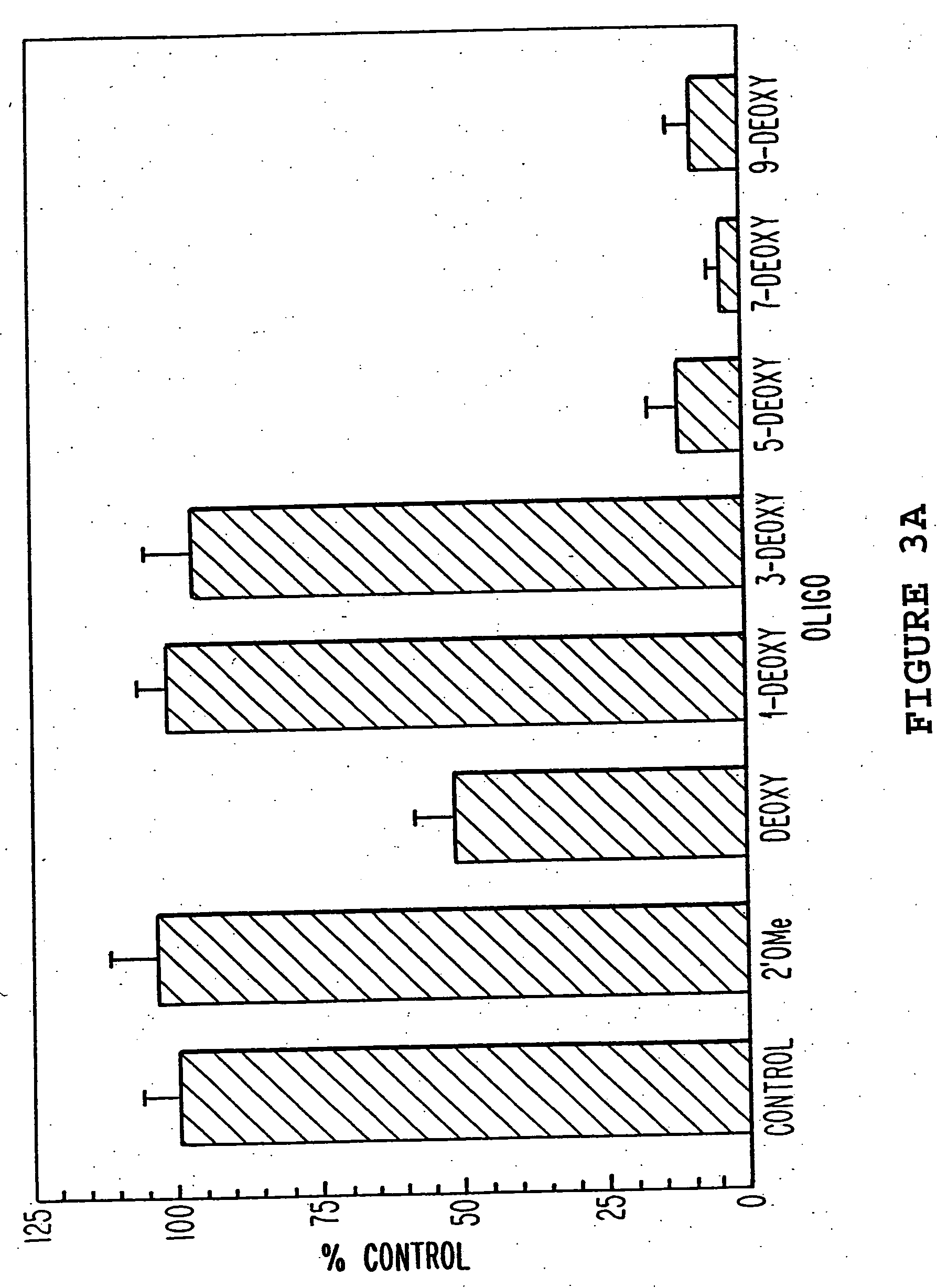Methods of using mammalian RNase H and compositions thereof
a technology of applied in the field of methods for composition, can solve the problems of detrimental nuclease degradation, oligonucleotides of this nature were not examined for cleavage efficiency using mammalian rnase h, and no antisense activity in cells, and no studies on the ability to direct rnase h clea
- Summary
- Abstract
- Description
- Claims
- Application Information
AI Technical Summary
Problems solved by technology
Method used
Image
Examples
example 1
Chimeric 2′-O-methyl Antisense Oligonucleotides with Deoxy Gaps, Targeted to Activated H-ras
[0070] Mutation of the ras gene, causing an amino acid alteration at one of three critical positions (one of which is codon 12) in the protein product, results in conversion to a form which is implicated in tumor formation. A gene having such a mutation is said to be “activated.” It is thought that such a point mutation leading to ras activation can be induced by carcinogens or other environmental factors. Overall, some 10 to 20% of human tumors have a mutation in one of the three ras genes (H-ras, K-ras, or N-ras). Oligonucleotides targeted to the H-ras codon-12 point mutation were effective in inhibiting expression of a ras-luciferase reporter gene system. A series of eleven phosphorothioate oligonucleotides, ranging in length between 5 and 25 bases, were made and tested for ability to inhibit mutant and wild type ras-luciferase in transient transfection assays. Based on the sequence of a ...
example 2
RNase H Analysis using E.coli l Extract
[0071] The oligonucleotides shown in Table 1 were characterized for their ability to direct RNase H cleavage in vitro using E.coli extract as a source for mammalian RNase H, and for antisense activity. RNase H assays were performed using a chemically synthesized 25-base oligoribonucleotide corresponding to bases +23 to +47 of activated (codon 12, G→U) H-ras mRNA. The 5′ end-labeled RNA was used at a concentration of 20 nM and incubated with a 10-fold molar excess of antisense oligonucleotide in a reaction containing 20 mM tris-Cl, pH 7.5, 100 mM KCl, 10 mM MgCl2, 1 mM dithiothreitol, 10 μg tRNA and 4 U RNasin in a final volume of 10 μl. The reaction components were preannealed at 37° C. for 15 minutes then allowed to cool slowly to room temperature. HeLa cell nuclear extracts were used as a source of mammalian RNase H. Reactions were initiated by addition of 2 μg of nuclear extract (5 μl) and reactions were allowed to proceed for 10 minutes at...
example 3
Determination of Antisense Activity of Chimeric Oligonucleotides Using a ras Transactivation Reporter Gene System
[0073] The oligonucleotides in Table 1 were tested for antisense activity against full length H-ras mRNA using a transient co-transfection reporter gene system in which H-ras gene expression was monitored using a ras-responsive enhancer element linked to the reporter gene luciferase. The expression plasmid pSV2-oli, containing an activated (codon 12, GGC-GTC) H-ras cDNA insert under control of the constitutive SV40 promoter, was a gift from Dr. Bruno Tocque (Rhone-Poulenc Sante, Vitry, France). This plasmid was used as a template to construct, by PCR, a H-ras expression plasmid under regulation of the steroid-inducible mouse mammary tumor virus (MMTV) promoter. To obtain H-ras coding sequences, the 570 bp coding region of the H-ras gene was amplified by PCR. The PCR primers were designed with unique restriction endonuclease sites in their 5′-regions to facilitate cloning...
PUM
 Login to View More
Login to View More Abstract
Description
Claims
Application Information
 Login to View More
Login to View More - R&D
- Intellectual Property
- Life Sciences
- Materials
- Tech Scout
- Unparalleled Data Quality
- Higher Quality Content
- 60% Fewer Hallucinations
Browse by: Latest US Patents, China's latest patents, Technical Efficacy Thesaurus, Application Domain, Technology Topic, Popular Technical Reports.
© 2025 PatSnap. All rights reserved.Legal|Privacy policy|Modern Slavery Act Transparency Statement|Sitemap|About US| Contact US: help@patsnap.com



